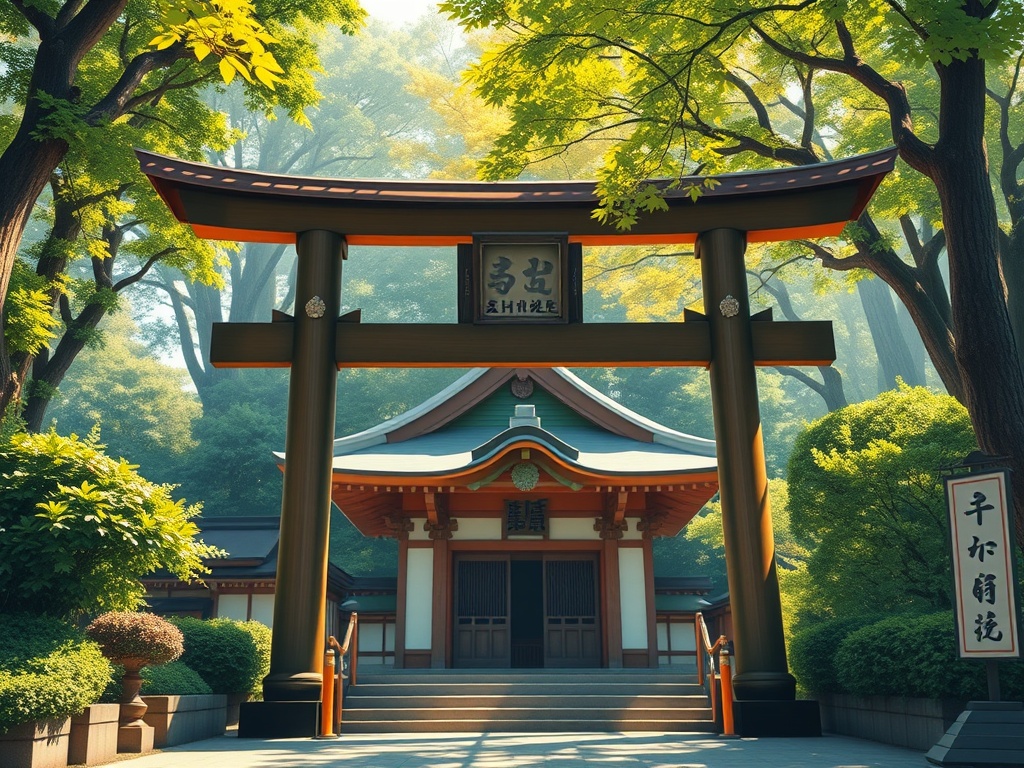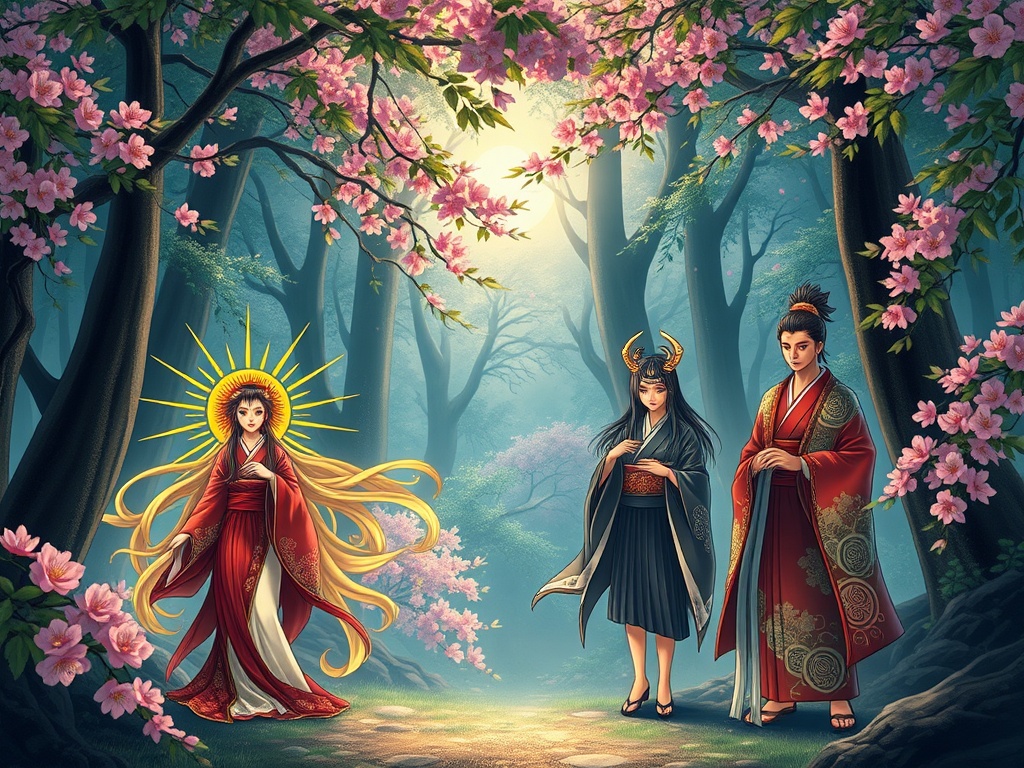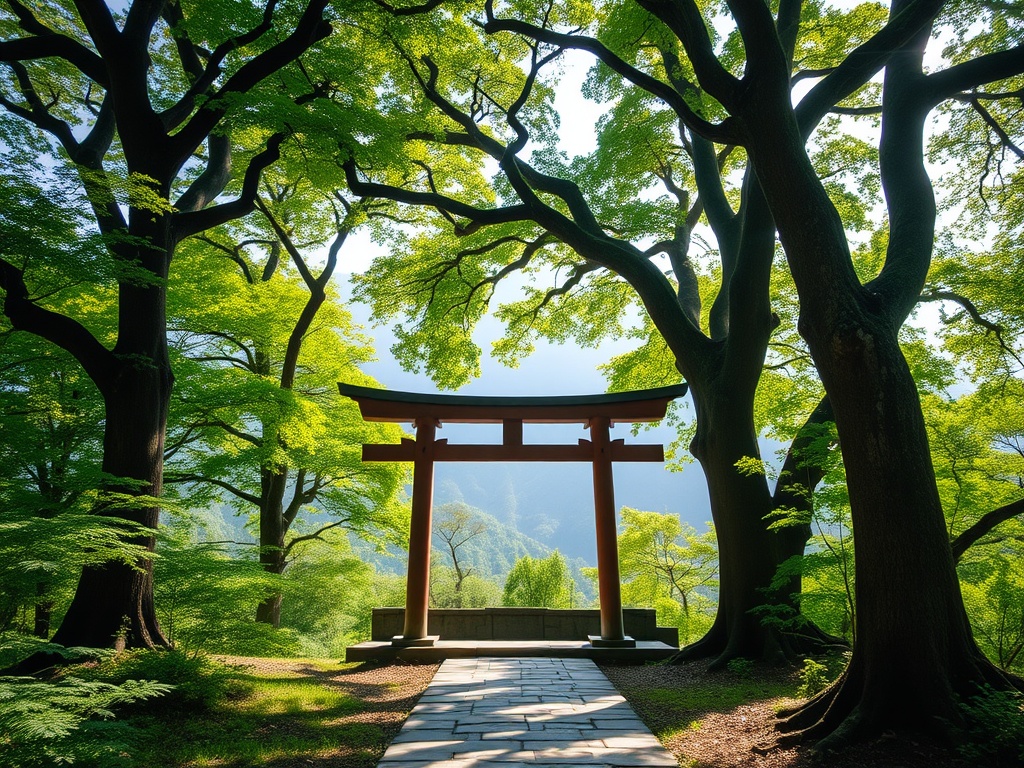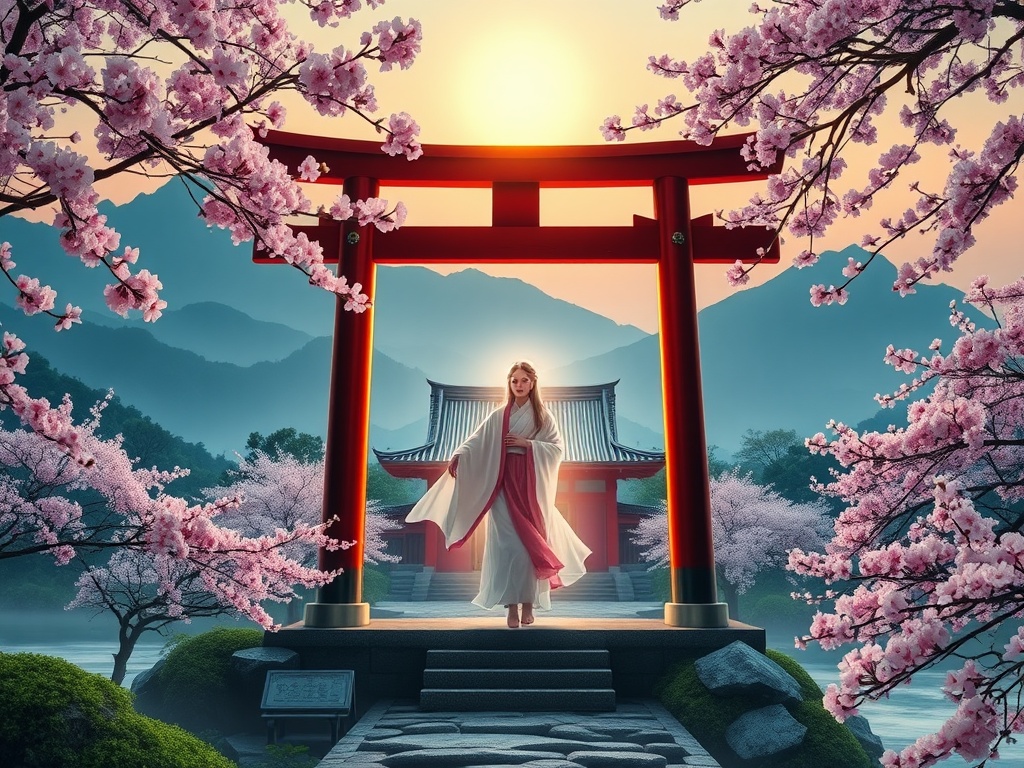Unveiling the Mystical Pantheon: Meet the Japanese Deities
Win a Free Trip to Japan!
Experience cherry blossoms and ancient temples
Japan, a land where the past and present blend seamlessly, is home to a diverse and fascinating pantheon of gods and goddesses that have shaped its culture and traditions. From the sun goddess Amaterasu to the mischievous fox spirit Inari, these deities hold a mirror to Japan’s rich history and spiritual beliefs. Whether you’re a seasoned traveler or a curious explorer, delving into the stories of these divine beings will enhance your journey through this enchanting nation.
At the heart of Japan’s spiritual landscape are four key deities that hold significant importance in Shinto and Buddhist traditions. Understanding these gods will offer you deeper insights into Japan’s cultural and religious practices.
- Amaterasu: Known as the Sun Goddess, Amaterasu is one of the most revered deities in Japan. She is considered the ancestor of the imperial family and a symbol of life and prosperity.
- Susanoo: The storm god and brother of Amaterasu, Susanoo is a complex figure known for his wild and unruly nature. His stories often depict themes of chaos and redemption.
- Tsukuyomi: The Moon God and sibling of Amaterasu and Susanoo, Tsukuyomi is often portrayed as a mysterious and aloof figure, representing the calm and tranquility of the night.
- Inari: Widely worshipped, Inari is the god of rice, agriculture, and prosperity, often associated with foxes, which are considered his messengers.
The influence of these deities extends beyond ancient rituals and myths, permeating contemporary Japanese culture in various forms. Festivals, traditional arts, and even popular media continue to draw inspiration from these divine figures.
For instance, the annual Matsuri festivals across Japan often celebrate these gods, with vibrant processions and symbolic offerings. Meanwhile, the narratives of these deities have found their way into modern anime and manga, captivating audiences worldwide with their timeless tales.
Embark on a spiritual adventure by visiting some of the most sacred sites dedicated to these gods. Each location offers a unique glimpse into the rituals and practices that honor these divine beings.
| Deity | Shrine/Temple | Location |
|---|---|---|
| Amaterasu | Ise Grand Shrine | Mie Prefecture |
| Susanoo | Izumo Taisha | Shimane Prefecture |
| Inari | Fushimi Inari Taisha | Kyoto |
From Shrines to Legends: Exploring Sacred Sites of the Kami
Japan’s spiritual landscape is a mosaic of enchanting shrines and temples, each resonating with the whispers of ancient legends and the reverent echoes of worshippers past and present. From the verdant forests of Kyoto to the coastal vistas of Shimane, these sacred sites offer a profound connection to the kami, the divine spirits that inhabit the natural world. As you journey through these hallowed grounds, you will discover a tapestry of stories and traditions that illuminate Japan’s spiritual heart.
Each shrine in Japan holds a unique story and spiritual significance, often dedicated to specific kami that embody the ideals of natural harmony and human virtues. Here are some of the most renowned shrines and the deities they honor:
- Ise Grand Shrine: Nestled in the serene landscapes of Mie Prefecture, this shrine is dedicated to Amaterasu, the Sun Goddess. It is considered the most sacred Shinto site in Japan, drawing pilgrims and seekers of spiritual solace.
- Izumo Taisha: Located in Shimane Prefecture, this shrine venerates Susanoo, the god of storms, and is famed for its ancient architecture and the annual Kamiari Festival, where all the deities of Japan are said to gather.
- Fushimi Inari Taisha: Situated in Kyoto, this iconic shrine is dedicated to Inari, the god of rice and prosperity. Its thousands of vermilion torii gates create a mesmerizing pathway leading visitors into the heart of spiritual devotion.
Visiting these sacred sites is not just about witnessing architectural wonders; it’s about immersing oneself in the rituals and traditions that have been practiced for centuries. Participate in purification rites, leave offerings, or simply wander through the tranquil surroundings to feel the presence of the kami.
Whether you’re a devotee seeking spiritual enlightenment or a traveler drawn by the allure of Japan’s cultural heritage, these sacred sites promise a journey of discovery and introspection. Embrace the silence, let the stories of the gods guide your path, and uncover the mystical beauty of Japan’s divine realms.
Mythical Stories Unraveled: Tales of Japanese Gods and Goddesses
Embark on a journey through the captivating myths and legends of Japanese gods and goddesses, where the boundaries between the earthly and the divine blur in a tapestry of tales that have enchanted generations. These stories, deeply embedded in Japan’s cultural and spiritual fabric, offer travelers and enthusiasts a glimpse into a world where deities walk among mortals, weaving narratives that explain nature, human behavior, and the cosmos.
In the beginning, the world as we know it was forged by the celestial siblings Izanagi and Izanami. These primordial deities descended upon the earth, creating the islands of Japan with a divine spear. From their union, an array of gods was born, including the fiery Kagutsuchi, whose birth led to the death of Izanami and the subsequent creation of the afterlife. This poignant tale not only serves as a creation myth but also underscores the delicate balance between life and death, a theme prevalent in Japanese spirituality.
The story of Amaterasu and Susanoo, the celestial siblings, further illustrates this cosmic balance. Amaterasu, the Sun Goddess, withdrew into a cave following a conflict with her tempestuous brother Susanoo, plunging the world into darkness. This myth explains the inherent duality of light and chaos, teaching the virtues of harmony and redemption. It is said that the gods collaborated to coax Amaterasu out, a testament to the power of unity and the importance of restoring balance to the world.
Among the pantheon of Japanese deities, Inari stands out not only for their association with rice and prosperity but also for the enigmatic fox spirits, or kitsune, that serve as their messengers. These shape-shifting beings are known for their playful trickery and ability to transform, embodying the unpredictable nature of fortune and the ever-changing seasons. Travelers exploring the Fushimi Inari Taisha in Kyoto can almost sense the presence of kitsune along the trails of vermilion gates, each turn whispering tales of cunning and transformation.
Another fascinating figure is the god Ebisu, one of the Seven Lucky Gods, known for his jovial nature and affinity for fishermen. Ebisu’s story is one of resilience and acceptance, as he was cast away at birth due to his imperfections but later embraced as a deity of luck and prosperity. His tale encourages embracing one’s flaws and finding joy and success despite them, a narrative that resonates with many seeking deeper meaning in their travel experiences.
These mythical stories, rich in symbolism and moral lessons, invite travelers to not only explore Japan’s sacred sites but also to engage with the cultural narratives that have shaped its spiritual landscape. As you delve into these enchanting tales, let the wisdom of the gods illuminate your path, offering insights and inspiration for your own journey.
Rituals and Festivals: Celebrating the Divine in Japanese Culture
Delve into the vibrant world of Japanese rituals and festivals, where the spiritual and the celebratory intertwine to honor the gods and goddesses that have long guided the nation. These events are not just religious observances; they are cultural extravaganzas that bring communities together, offering a unique window into Japan’s rich spiritual heritage. As you travel through Japan, participating in these festivals or witnessing the rituals will enrich your understanding of the land’s divine connections.
Japan’s calendar is punctuated by numerous festivals, each with its own unique customs and significance. These celebrations often correspond with the agricultural calendar, reflecting the deep connection between the gods and the earth’s bounty. Here’s a list of some of the most captivating festivals that celebrate the divine:
- Shogatsu (New Year): Marking the beginning of the year, Shogatsu is a time to honor the gods with offerings at local shrines. Families clean their homes to welcome the Toshigami, or New Year god, ensuring prosperity and good fortune.
- Tanabata (Star Festival): Celebrated in July or August, this festival honors the deities Orihime and Hikoboshi, represented by the stars Vega and Altair. The festival is marked by colorful decorations and wishes written on tanzaku paper, hung on bamboo branches.
- Obon: Occurring in August, Obon is a time when it is believed the spirits of ancestors return to the living world. Special dances called Bon Odori are performed to welcome these spirits, and lanterns are floated on rivers to guide them back to the afterlife.
Beyond the lively festivals, numerous sacred rituals allow individuals to connect with the gods on a more personal level. These practices, steeped in tradition, are an integral part of daily life and offer travelers a chance to experience the spiritual essence of Japan.
Meditative Practices: Engage in serene meditation sessions at temples, where the chants of monks and the calming environment create a peaceful atmosphere for reflection and spiritual connection.
Shinto Purification: Witness or partake in purification rituals at shrines, where a priest performs the harae ceremony, cleansing participants of spiritual impurities and inviting blessings from the kami.
Tea Ceremonies: Participate in a traditional tea ceremony, a ritualistic practice that embodies the principles of harmony, respect, and tranquility, offering a meditative experience that honors the gods and nature.
Guardians of Nature: Understanding the Role of Shinto Spirits
Japan, with its breathtaking landscapes and deep-rooted spiritual traditions, is a realm where the natural and the supernatural converge. At the heart of this spiritual tapestry are the Shinto spirits, or kami, revered as the guardians of nature. These spirits are believed to inhabit every aspect of the natural world—from towering mountains and flowing rivers to the smallest pebble and blade of grass. To truly appreciate the beauty and mysticism of Japan, one must delve into the world of these divine caretakers.
The Shinto religion, a cornerstone of Japanese spirituality, emphasizes the harmony between humans and nature. The kami are not distant deities but rather a part of the very fabric of the environment. Each natural element is imbued with its own spirit, making every encounter with nature a potential meeting with the divine. For travelers, this means that every hike through a forest or stroll along a beach is a chance to connect with the sacred. Many Japanese people and visitors alike partake in rituals to honor the kami, offering prayers and gifts to ensure balance and prosperity.
In Japan, the presence of the kami is felt not only in grand shrines but also in the everyday landscapes encountered by travelers. The majestic Mount Fuji, for instance, is considered a kami in itself, a symbol of endurance and serenity. Similarly, the ancient cedar trees of Yakushima Island are revered as living embodiments of the gods. Engaging with these sites offers travelers a profound sense of peace and an understanding of the delicate balance maintained by these spiritual guardians. Whether visiting a bustling city or a tranquil countryside, the spirit of the kami is woven into the essence of Japanese life.
Enigmatic Symbols: Discover the Art and Iconography of Japanese Deities
Japan’s divine pantheon offers not only fascinating stories and myths but also a rich tapestry of artistic expressions that bring these deities to life. The art and iconography associated with Japanese gods and goddesses are an integral part of the country’s cultural heritage, reflecting the profound spiritual beliefs and artistic sensibilities of its people. For travelers and art enthusiasts, exploring these visual representations offers a captivating journey into the heart of Japan’s spiritual and artistic landscape.
Each Japanese deity is represented by a unique set of symbols, colors, and motifs that convey their divine attributes and powers. For instance, the sun goddess Amaterasu is often depicted with a radiant halo, symbolizing her role as the bringer of light and life. Similarly, Susanoo, the storm god, is frequently shown with tumultuous waves and swirling clouds, embodying his tempestuous nature.
These artistic elements are not mere decorations but are imbued with layers of meaning that reflect the complex narratives of the gods they portray. The presence of kitsune, or foxes, in the iconography of Inari shrines, highlights their role as messengers and protectors, while the serene visage of Tsukuyomi, the moon god, is often used to evoke tranquility and introspection. Travelers exploring temples and museums will find themselves immersed in a visual dialogue that captures the essence of these divine figures.
Over the centuries, the depiction of Japanese deities has evolved, influenced by changing artistic styles and the fusion of Shinto and Buddhist iconography. Early depictions were characterized by simplicity and abstraction, reflecting the indigenous animistic beliefs. With the introduction of Buddhism, the art became more intricate, incorporating elements such as mandalas and celestial beings.
The Edo period saw a flourishing of ukiyo-e woodblock prints, where artists like Hokusai and Hiroshige captured the gods in vivid detail, blending mythological themes with the aesthetics of the floating world. These prints not only served as religious art but also as popular cultural artifacts that brought the divine into the everyday lives of the people.
Today, contemporary artists continue to draw inspiration from traditional motifs, reimagining the gods in new forms and mediums that resonate with modern audiences. As you journey through Japan, take the time to explore galleries and exhibitions that showcase these ever-evolving representations, offering a fresh perspective on the timeless allure of Japanese deities.



